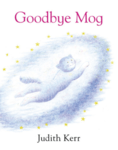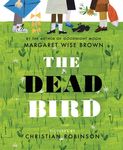Death in children’s books
Kids’ books are tools to explain and discuss the greatest adventures, including, and most importantly, death and dying. From picture books to genre fiction, here’s a look at kids’ books that discuss death. This is to remind you that being a child is a time of rolling about in mud, eating sweets out of a paper bag and harbouring deeply profound thoughts relating to death.
[SPOILER ALERT: This article contains detailed summaries of the books mentioned. Though, if you still haven’t figured out how Harry Potter ends, maybe you’d finally like that stone overturned for you.]Goodbye Mog, by Judith Kerr
In Goodbye Mog, Judith Kerr dares to go where no writer goes without an accompanying sense of fear: she kills off our hero ON THE FIRST PAGE. Mog realises she’s had a good run: a life of comfort, in a nice family home with a large amount of adventures under her belt. Mog checks out on the first page, but sticks around to see how the Foster family reacts:
Mog was tired. She was dead tired…Mog thought, ‘I want to sleep forever.’ And so she did. But a little bit of her stayed awake to see what would happen next.
As the reviews on Goodreads suggest, not everyone is taken by this plot device. However, Mog’s decision to stay ‘awake to see what would happen next’ conjures up profound questions relating to existence. Is that ‘little bit of her’ which stayed awake her soul? Is the Mog in the rest of the story still the same Mog? Is ‘sleep’ just the metaphor Mog needs to slowly come to terms with her death?
While we leave these questions to be answered by the smaller ones (unless you really want to tell us your thoughts in which case, email us at [email protected]?), Judith Kerr herself has suggested that, overall, Mog’s death was one of convenience: “I’ve done enough Mog books – you know, drawing all those stripes became very tedious. I wished sometimes I’d made her a plain-coloured cat.”
The Dead Bird, by Margaret Wise Brown
Back in 1938, a dead bird took the children’s publishing industry by storm. On the first page, a group of children wandering about in a forest discover a bird on the ground with Brown matter-of-factly announcing, “The bird was dead when the children found it.”
The book has an unsentimental quality which gives the sight of the dead bird a compelling simplicity. It’s a quiet book, free of intruding adults, and The Dead Bird focuses on the ways in which the children improvise rituals when confronted with death. The children seem to have an intuitive sense of the nature of dead things, as they realise:
That was the way animals got when they had been dead for some time – cold dead and stone still with no heart beating.
They bury the bird under a tree and conduct their own funeral, complete with mourning song and a makeshift headstone. They realise without alarm, “You’ll never fly again”.
While you may think that the book sounds like a masterpiece of just stating the bleeding obvious, The Dead Bird is about the commonplace nature of death and the ways we cope with it.
 Duck, Death and the Tulip, by Wolf Erlbruch
Duck, Death and the Tulip, by Wolf Erlbruch
The German children’s book author and illustrator Wolf Erlbruch offers a simple enough story: one day, Duck turns around to find Death standing behind her. Duck is surprised, but Death reminds her that he has been there her entire life. The two strike up a familiarity:
Duck warms Death up when he gets cold – ‘“Are you cold?” Duck asked. “Shall I warm you a little?” Nobody had ever offered to do that for Death.’
The two share walks together and discuss what will happen to the nearby pond when Duck dies. It’s the unlikely duo’s riffs on the pond that provide a larger debate on the nature of death and humans’ tendency to have delusions of immortality. As Death says, “When you’re dead, the pond will be gone, too – at least for you.” The universe keeps going, things stay put, even when you’re not there to witness it: “That’s what it will be like when I’m dead,” Duck thought. “The pond alone, without me.”
If this is making your head spin, we can only wonder what the kids will think of these forays into the concept of non-existence. However, perhaps these ideas aren’t as complex as we think they are: as Death says, “But that’s life”.
A Monster Calls, by Patrick Ness 
This one features a monster, so we’re starting off on the right note. Monsters, farts, unfortunate accidents – these are the fundamental building blocks of the children’s book. Though, A Monster Calls by Patrick Ness is more for the older crowd.
A monster visits Conor every night and begins to help Conor process his mum’s illness. The monster offers to tell him three stories – only if Conor then tells his own story afterwards.
The book is about opening up, the way the grieving process isn’t always so straightforward and the impact of stories on our own lives. As the monster tells Conor, “Stories don’t always have happy endings.” Conor learns that there’s no one way to grieve – other than sadness, it can involve anger and guilt, too. Both honest and moving, Conor begins to open up: by allowing himself to be frank with the monster, we learn that he is bullied at school and that he has strained relationships with his father and grandmother.
The stories are equal parts conversation and folktale, with tough questions asked and answered at every turn. As Conor says, ‘That’s one thing the monster had definitely taught him. Stories were wild, wild animals and went off in directions you couldn’t expect.’
 The Harry Potter series, JK Rowling
The Harry Potter series, JK Rowling
As every child of a certain age will tell you, if you’ve not heard of Harry Potter then you must have lived under a rock, staring at a wall, slowly becoming more and more irrelevant, for literally thousands of years.
Producing the melancholy goods is the sheer amount of death Harry comes up against. While Dumbledore, in the very first book, remarks that, ‘To the well-organised mind death is but the next great adventure’, most of the death in the book is a scary, formless thing associated with evil forces. Harry Potter’s parents’ death is just the start of things.
Dumbledore is by far the most wise of the wizards, as he seems to command a great view of death. Not just well-organised, his mind seems to cut through all the woolly thinking around death. As he tells Harry in Harry Potter and the Half-Blood Prince: “It is the unknown we fear when we look upon death and darkness, nothing more.”
When we get to the final showdown, where Harry Potter must duel baldy nemesis Voldemort to the death, Harry calls on the memory of his parents and other lost loved ones to give him a bit of courage. It’s Sirius Black’s words from The Prisoner of Azkaban that seem the most resonant: “The ones who love us never really leave us”.
When it comes to that conversation about death, books are guaranteed to start it. Rather than sentimental, children’s books can offer a level-headed but complex look at death.
If you would like to get hold of any the books mentioned in the article, click the image to find it on Amazon.








